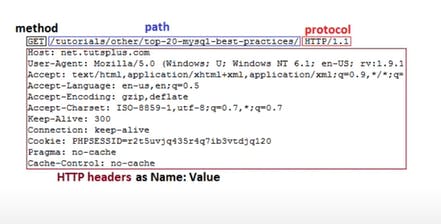What is HTTP?
HTTP stands for Hyper Text Transfer Protocol. It is responsible for communication between web clients and servers by sending HTTP Requests and receiving HTTP Responses. It is also responsible for loading pages, form submission and making Ajax calls. It is stateless which means every request is independent (For eg: if you load a page or visit another page, it won't remember this transaction)
What is HTTPS?
HTTPS stands for Hypertext Transfer Protocol Secure. It is a protocol that secures communication and data transfer between a user's web browser and a website. HTTPS is the secure version of HTTP. The protocol protects users against eavesdroppers and man-in-the-middle (MitM) attacks by encrypting the data using SSL or TLS which is a certification offered by a third-party organization (for eg: GoDaddy)
What is SSL?
An SSL certificate is code on your web server that provides security for online communications. When a web browser contacts your secured website, the SSL certificate enables an encrypted connection.
What is TLS?
Transport Layer Security (TLS) encrypts data sent over the Internet to ensure that eavesdroppers and hackers are unable to see what you transmit which is particularly useful for private and sensitive information such as passwords, credit card numbers, and personal correspondence. Transport Layer Security (TLS) is the successor protocol to SSL. TLS is an improved version of SSL.
Basics Methods of HTTPS:
GET: Retrieves/Gets data from a server
POST: Submit/Post data to a server
PUT: Update data already available on a server.
DELETE: Delete data from a server
HTTP Header Fields:
An HTTP header is a field of an HTTP request or response that passes additional context and metadata about the request or response.

General:
Request URL
Request Method
Status Code:
Remote Address: The IP of the remote computer
Referrer Policy: The norm/policy that allows the transaction of data from one page to another/
Response:
Server: Apache, EngineX
Set-Cookie: Allows servers to send small bits of data(cookies) from server to client.
Content-Type: .html, .cs., .js - extension
Content-Length
Date
Request:
Cookies
Accept-xxx
Content-Type
Content-Length
Authorization
User-Agent: A long string that is associated with the user's browser
Referrer
HTTP Status Codes
1xx: Informational: request received/processing
2xx: Success: Successfully received, understood and accepted
3xx: Redirect: Further action must be taken/redirected
4xx: Client Error: Request does not have what it needs
5xx: Server Error: The server failed to fulfil an apparent valid request.

